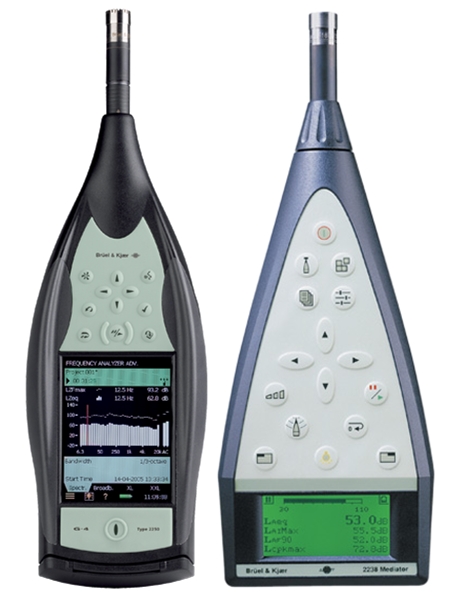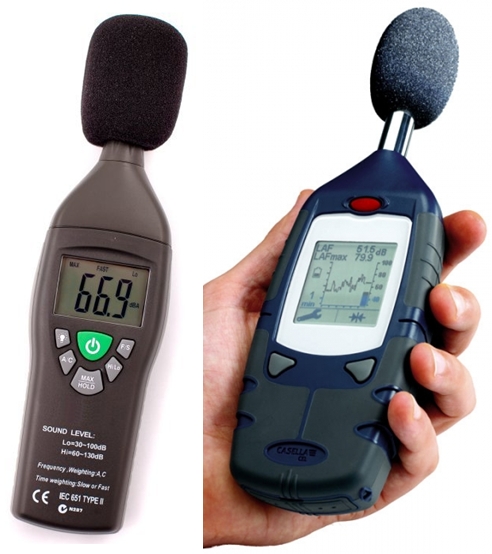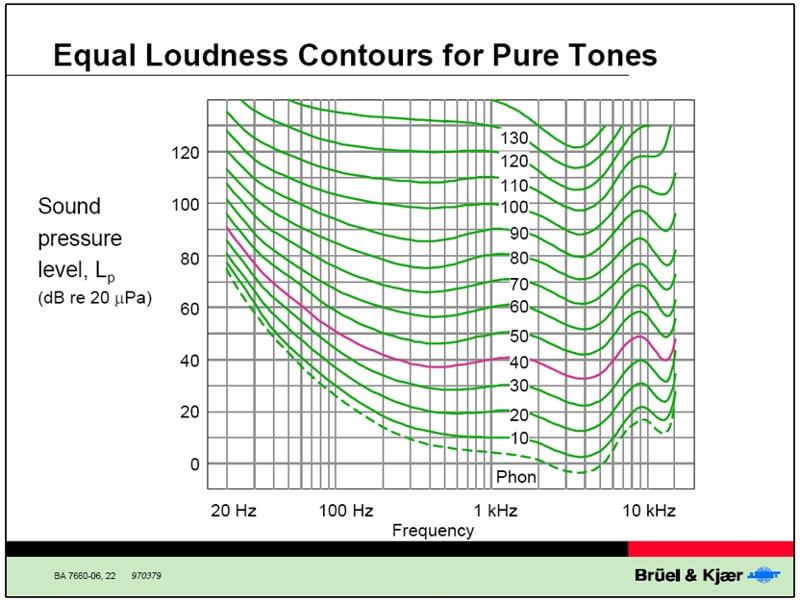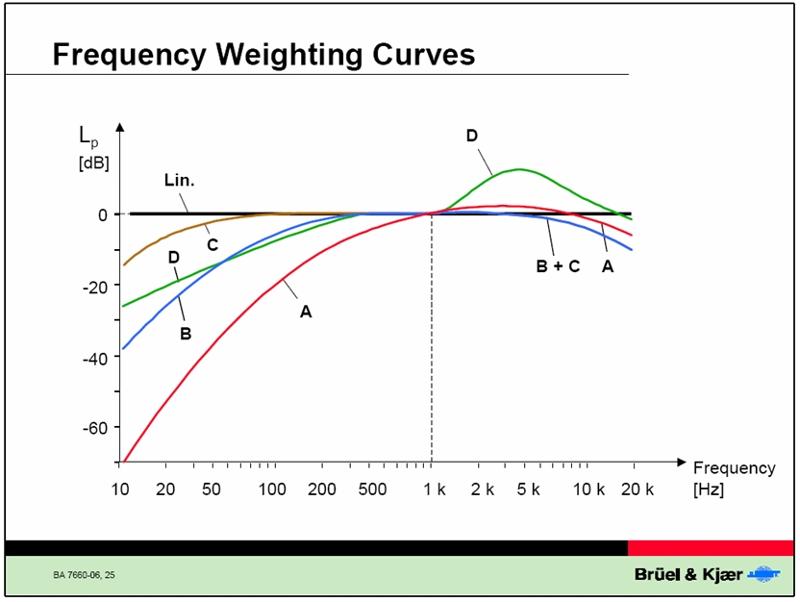Sound Level Meters
In this brief section we will look at the basics of sound level meters. We will stick primarily to the sort of SLMs used for calibration of audiological equipment and those you might use to check free-field sound levels for speech-testing etc. In the previous section we mentied about how to calibrate SLMs and we will revisit this later.
Types of Sound Level Meters
There are 4 basic categories of sound level meters which are defined on the basis of their features, but more importantly their accuracy. These are defined in BS EN 61672-1:2003 Electroacoustics - Sound level meters. Specifications (with other information in other parts of BS EN 61672).
Class 1 SLMs:
Tolerances of between 1 to 3 dB over the frequency range 12.5 Hz to 8 kHz (+/- 1.1 dB at 1 kHz)
- It is these SLMs that should be used for calibration purposes.
- They have removable microphones and preamplifiers to enable them to be attached to couplers.
- A larger range of functionality aften including 1/3 octave spectrum analysis to allow the frequency content of a signal to be assessed.
- Additional software can often be purchased for more compelx analysis (e.g. reverberation time measurement or data logging).
Below are two examples of Bruel and Kjaer Class 1 sound level meters
Figure 5 - examples of class 1 SLMs

Figure 5 - examples of two class 1 sound level meters (the two that we have in the lab). These devices can have different analysis software installed so that they can be used for simple ound level readings (e.g. the one on the right), or more complex measuremenst such as 1/3-octave spectrum analysis (as shown on the one on the left).
Class 2 SLMs:
- Tolerances of between 1.4 to 5.6 dB over the frequency range 12.5 Hz to 8 kHz (+/- 1.4 dB at 1 kHz)
- Can be used for day to day checking of free-field sound levels, but not calibration
- Fixed microphone that cannot be changed for another type
- More limited range of settings, generally limited to dB(A) and dB(C) and Fast, Slow and Impulse time settings.
(so called Class 3 SLMs are not included in the above mentioned standard and are really just sound level indicators rather than measurement devices)
Below are two examples of Class 2 sound level meters:
Figure 6 - examples of class 2 SLMs

Figure 6 - two examples of class 2 SLMs. The one on the left is an extremely cheap model that can be bought for less than £50 - I have my doubts as to whether it fully conforms to the standards. The one on th eright is a professional quality class 2 SLM (the type we use in the lab).
Frequency Weightings in SLMs
The three most important frequency weightings that we see on SLMs are dB(Z) or linear; dB(A) and dB(C)
dB(Z) - linear: this is a flat frequency response so that if a single sound level is being measured then all frequencies going into the microphone are weighted equally (even if they are outside the range of human hearing). It is this setting that should be used for calibration of audiometric equipment.
dB(A) and dB(C): the human auditory system does not have a flat frequency response and this can be shown by measuring equal loudness contours (ELCs) where listeners are asked to match the level of ounds of different frequencies to a reference at 1kHz. If this is done at a range of levels we see that the auditory system has a flatter frequency response at higher levels than at low. The dB(A) and dB(C) settings are designed to take this variation in sensitivity into account. A measurement in dB(A) will filter out low frequencies to try to mimic the frequency response of the auditory system. The dB(A) setting is designed to mimic the 40-phon ELC (i.e. when sounds are matched to a 1 kHz reference tone at 40 dB SPL. The dB(C) setting is designed to mimic the 100-phon ELC (i.e. when sounds are matched to a 1 kHz reference tone at 100 dB SPL. Thus the dB(C) weighting is flatter than the dB(A). Class 2 sound level meters typically only have the dB(A) and dB(C) settings and so if a 'flat' weighting is required the dB(C) should be used, or better still get a Class 1 SLM.
The following graph shows a set of equal-loudness contours for normal hearing listeners, the 40-phon contour is highlighted.
Figure 7 - equal loudness contours

Figure 7 - plot of frequency/threshold curve for minimum audible field (dashed line) plus equal loudness countours measured at different reference levels. The 40 phon ELC is the one on which the 'A-weighting' for SLMs is based. The key point here is that this curve reflects a decrease in sensitivity of the ear towards lower and higher frequencies. The 'C-weighting' is based on the flatter 100-phon equal loudness contour.
If the 40-phon and 100-phon equal loudness countours are turned upside down and smoothed (and set to 0dB attenduation at 1kHz) the the dB(A) and dB(C) weightings are produced. The following graph shows these (and other) weightings.
Figure 8 - Frequency weighting curves used in SLMs

Figure 8 - different frequency weighting curves used in th emeasurement of sound. In SLMs the commonly used ones are A, C and Linear (also referred to as Z). dB SPL(A) is typically used to measure sound at moderate levels (e.g. background noise in a room). dB SPL(C) is more typically used for the measurement of high-level sounds.
Time Weightings for SLMs
In addition to the frequency weightings SLMs also have time-weightings. These settings determine the time period over which the rms signal level is calculated (i.e. averaging or smooting time). There are three settings used on most SLMs:
- Fast: 125ms averaging time
- Slow: 1000ms averaging time
- Impulse: 35ms averaging time (designed to catch sudden peaks in the signal, often associated with some sort of capture-hold and reset mechanism - cannot be used for calibration of transient signes though, see later).
With the fast and slow setting, the choice of whcih to use depends on the signal - obviously the slow setting will average more, but it will also take a lot longer to settle to changes in the signal.
Standards relating to and defining their performance of SLMs
- BS EN 61672-1:2013 Electroacoustics. Sound level meters (part 1 - specifications)
- BS EN 61672-2:2013 Electroacoustics. Sound level meters (part 2 - pattern evaluation tests)
- BS EN 61672-3:2013 Electroacoustics. Sound level meters. Periodic tests